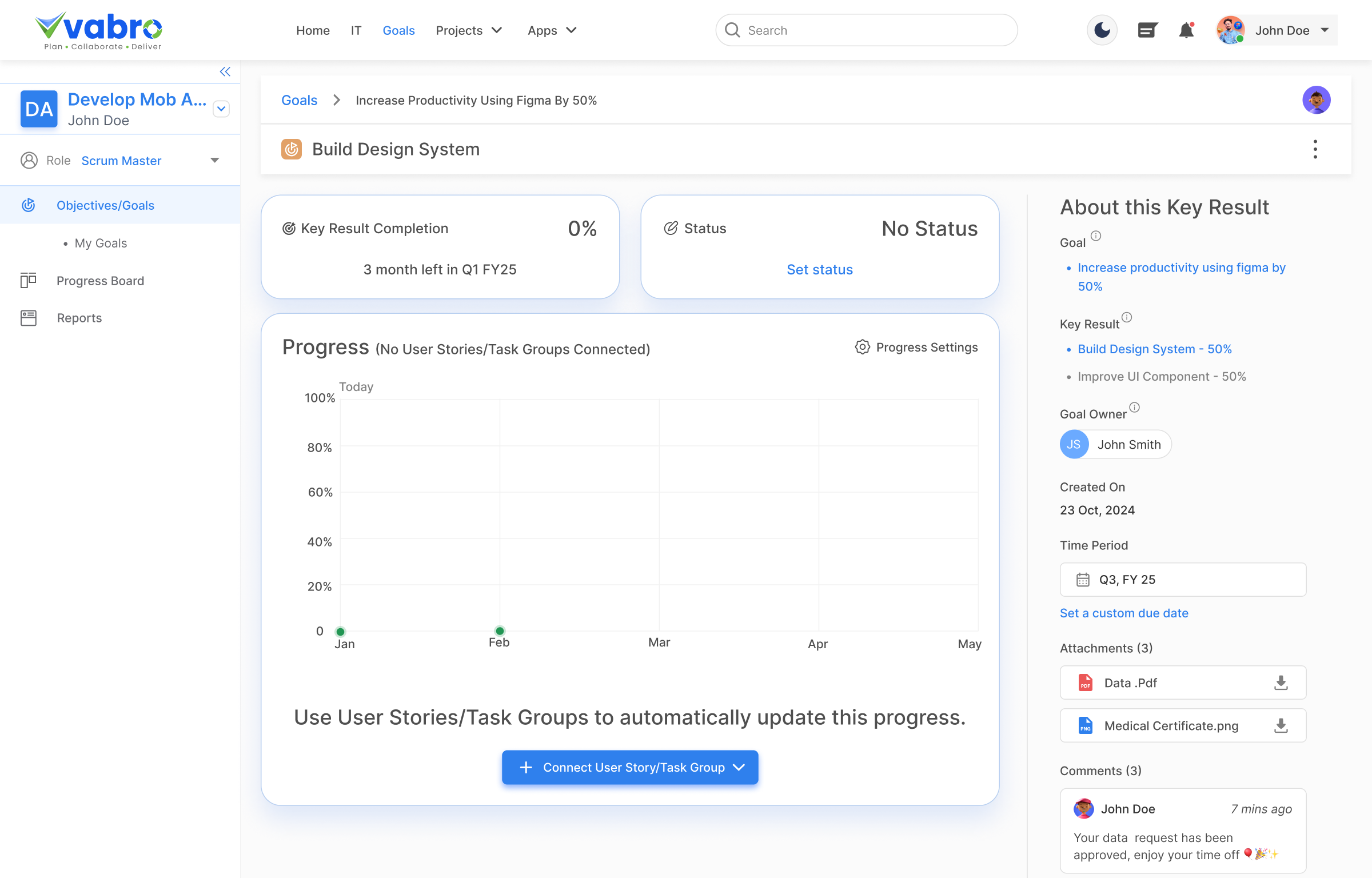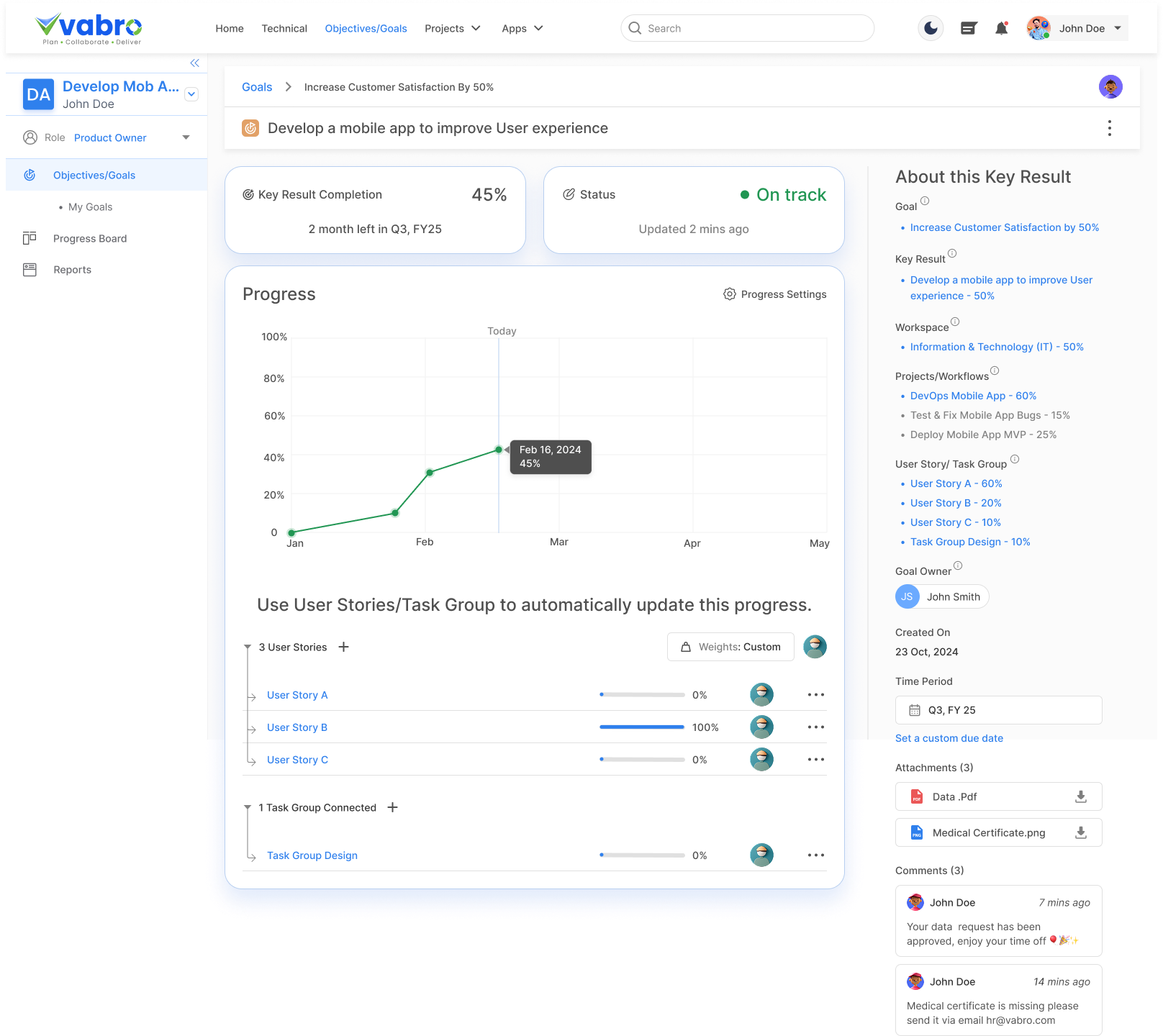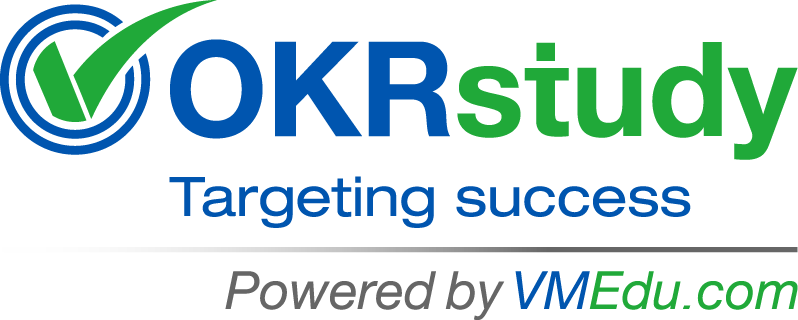In Agile Frameworks such as Scrum, Kanban and DevOps, the emphasis is on high level User Stories or Task Groups to be defined by the manager (such as Product Managers, Scrum Masters, Kanban Managers, DevOps Managers etc.), but the team doing the work has the flexibility to break User Stories/Task Groups into tasks as per their needs and convenience. In this case, tracking OKRs at a Task level may be too onerous and such granular OKR tracking may not deliver significant value. So, it is highly recommended to track OKRs a User Story/Task Group level and not break down OKRs to Tasks level. For example, if it is a Scrum Project, the most granular level to which we track Scrum Projects is at a User Story level; for Workflows, it is at a Task Group level.
Introduction
Objectives and Key Results (OKRs) are a powerful goal-setting framework designed to drive focus, alignment, and measurable outcomes across organizations. When integrated with Agile methodologies such as Scrum, Kanban, and DevOps, OKRs can significantly enhance productivity, strategic alignment, and continuous improvement. This document explores how to align OKRs with these leading Agile frameworks effectively.
1. Aligning OKRs with Scrum
Scrum is an iterative, incremental Agile framework primarily used in software development and project management. It focuses on delivering value in short, time-boxed iterations called sprints.
Key Alignment Strategies:
- Sprint Goals as OKRs: Align sprint goals with team or organizational OKRs to ensure each sprint contributes to broader objectives. For example, if the OKR is to "Improve User Engagement," a sprint goal could be "Implement new onboarding features to reduce user churn." This creates a direct connection between daily activities and strategic outcomes, enhancing team focus.
- Product Backlog Prioritization: Use OKRs to prioritize backlog items. Features and tasks that directly impact key results should be given higher priority, ensuring alignment with strategic goals. This helps product owners make data-driven decisions when managing the backlog, reducing the risk of misaligned efforts.
- Review and Retrospectives: Integrate OKR reviews into sprint retrospectives to assess how sprint outcomes contributed to key results. This fosters a culture of continuous improvement by encouraging reflection on both the process and the results. Teams can adjust their approach in subsequent sprints to better align with objectives.
- Cross-Functional Collaboration: Scrum promotes cross-functional teams. Aligning OKRs encourages collaboration between developers, testers, and stakeholders to achieve shared goals, breaking down silos and enhancing communication.
- Agile Coaching Integration: Incorporate Agile coaches to facilitate OKR adoption within Scrum teams. Coaches can help identify gaps, provide guidance on best practices, and ensure that OKRs are effectively driving team performance.
Example:
- Objective: Enhance product reliability.
-
Key Results:
- Reduce critical bugs by 40%.
- Improve test automation coverage to 90%.
- Sprint Goal: Complete the migration to the new testing framework to support improved reliability.
Figure A.1 shows the use of the Prioritized Product Backlog for prioritizing requirements aligned with OKRs.

Figure A.1: Aligning OKRs with User Stories in Scrum (Source: Vabro)
Figure A.1 above displays a progress tracking dashboard for an OKR, showing key result completion at 45%, connected user stories, goal alignment, and project contributions
2. Aligning OKRs with Kanban
Kanban is a visual workflow management method that emphasizes continuous delivery, flexibility, and efficiency. It focuses on managing work in progress (WIP) and optimizing flow.
Key Alignment Strategies:
- Flow Metrics as Key Results: Align key results with flow-based metrics such as cycle time, lead time, and throughput. For example, an OKR might focus on "Reducing cycle time by 20%" to improve delivery speed. Tracking these metrics helps teams identify bottlenecks and optimize their processes.
- Visual Management: Display OKRs on Kanban boards to maintain visibility and ensure teams are constantly reminded of strategic priorities. This transparency helps in keeping everyone aligned and focused on high-impact tasks.
- Continuous Feedback: Incorporate OKR discussions into regular Kanban cadences, such as replenishment meetings and service delivery reviews. This ensures that OKRs are not set and forgotten but are part of the ongoing workflow.
- Limiting Work in Progress (WIP): By limiting WIP, teams can focus on completing tasks that contribute directly to key results, improving efficiency and goal alignment.
- Data-Driven Improvements: Use Kanban metrics to evaluate the impact of changes and improvements on OKR progress, fostering a culture of data-driven decision-making.
- Value Stream Mapping: Apply value stream mapping to identify inefficiencies and align OKRs with key areas for process improvement, maximizing the flow of value to the customer.
Example:
- Objective: Improve operational efficiency.
-
Key Results:
- Decrease average cycle time from 10 to 7 days.
- Increase on-time delivery rate to 95%.
- Kanban Practice: Limit WIP to improve flow and achieve cycle time reduction.
Figure A.2 shows use of OKRs in a Kanban initiative.

Figure A.2: Aligning OKRs to Task Groups in a Kanban Initiative (Source: Vabro)
Figure A.2 above shows a Vabro platform dashboard for tracking organizational and individual IT goals, focusing on "Organization Goals/Objectives" and a visible progress board. It highlights key results and their progress toward objectives such as "Increase Customer Satisfaction by 50%," "Improve Customer Response Time," and "Enhance Ticket Resolution Efficiency," each with specific timelines and assigned personnel.
3. Aligning OKRs with DevOps
DevOps is a set of practices that combines software development and IT operations to shorten the development lifecycle and deliver high-quality software continuously.
Key Alignment Strategies:
- Performance Metrics as Key Results: Align OKRs with DevOps performance indicators like deployment frequency, change failure rate, mean time to recovery (MTTR), and lead time for changes. These metrics provide quantifiable measures of progress and help identify areas for improvement.
- Automation Goals: Set OKRs that focus on improving automation in CI/CD pipelines, infrastructure as code, and monitoring systems to enhance reliability and scalability. Automation reduces manual errors and increases deployment speed, directly impacting key results.
- Cultural Alignment: Use OKRs to promote a culture of collaboration between development and operations teams, driving shared accountability for outcomes. This helps break down traditional silos and fosters a DevOps mindset of continuous improvement.
- Feedback Loops: Integrate continuous feedback loops from monitoring tools and user feedback into OKR reviews to ensure that objectives are aligned with real-world performance and customer needs.
- Incident Management: Align OKRs with incident response objectives to improve system reliability and reduce downtime. For example, an OKR could focus on "Reducing incident response time by 30%."
- Resilience Engineering: Incorporate resilience engineering practices into OKRs, focusing on system robustness, fault tolerance, and rapid recovery capabilities.
Example:
- Objective: Accelerate software delivery.
-
Key Results:
- Increase deployment frequency from weekly to daily.
- Reduce MTTR from 4 hours to 1 hour.
- DevOps Practice: Implement automated rollback mechanisms to reduce recovery time.
Figure A.3 shows alignment of Releases with OKRs in a DevOps initiative.

Figure A.3: Aligning OKRs with User Stories or Task Groups in DevOps (Source: Vabro)
Figure A.3 above displays a "Portfolio Release Dashboard" in Vabro, showcasing a list of software releases for the "Vabro Portfolio." It includes release names, release dates, progress in terms of completed features, and overall status (Ongoing, Scheduled, or Completed). For example, "Vabro Release 1" and "Release V1.0" are marked as ongoing, "Release V3.0" and "Release V2.0" are scheduled, while "Release V4.0" has been completed. Aligning releases with OKRs in DevOps initiatives ensures the delivery of high value within a short duration and supports the achievement of company goals in the long run.
4. Best Practices for Aligning OKRs with Other Agile Frameworks
- Clear and Measurable Key Results: Ensure key results are quantifiable and time-bound.
- Regular Check-Ins: Conduct regular OKR check-ins aligned with Agile ceremonies (sprint reviews, Kanban stand-ups, or DevOps retrospectives).
- Cross-Functional Collaboration: Promote collaboration across teams to achieve shared OKRs, fostering a unified approach to goal attainment.
- Flexibility and Adaptation: Allow OKRs to evolve based on feedback and changing priorities within Agile environments.
- Tool Integration: Utilize OKR software tools integrated with Agile project management tools to streamline tracking and reporting.
- Leadership Involvement: Ensure leadership is actively involved in setting and reviewing OKRs to maintain strategic alignment.
- Transparency and Visibility: Make OKRs visible at all organizational levels to foster accountability and alignment.
- Outcome Over Output Focus: Emphasize outcomes (impact) rather than outputs (tasks completed) when setting and reviewing OKRs.
Conclusion
Aligning OKRs with Agile frameworks like Scrum, Kanban, and DevOps creates a powerful synergy that enhances strategic focus, operational efficiency, and continuous improvement. By integrating OKRs into Agile practices, organizations can drive measurable outcomes, improve team alignment, and foster a culture of accountability and growth.
